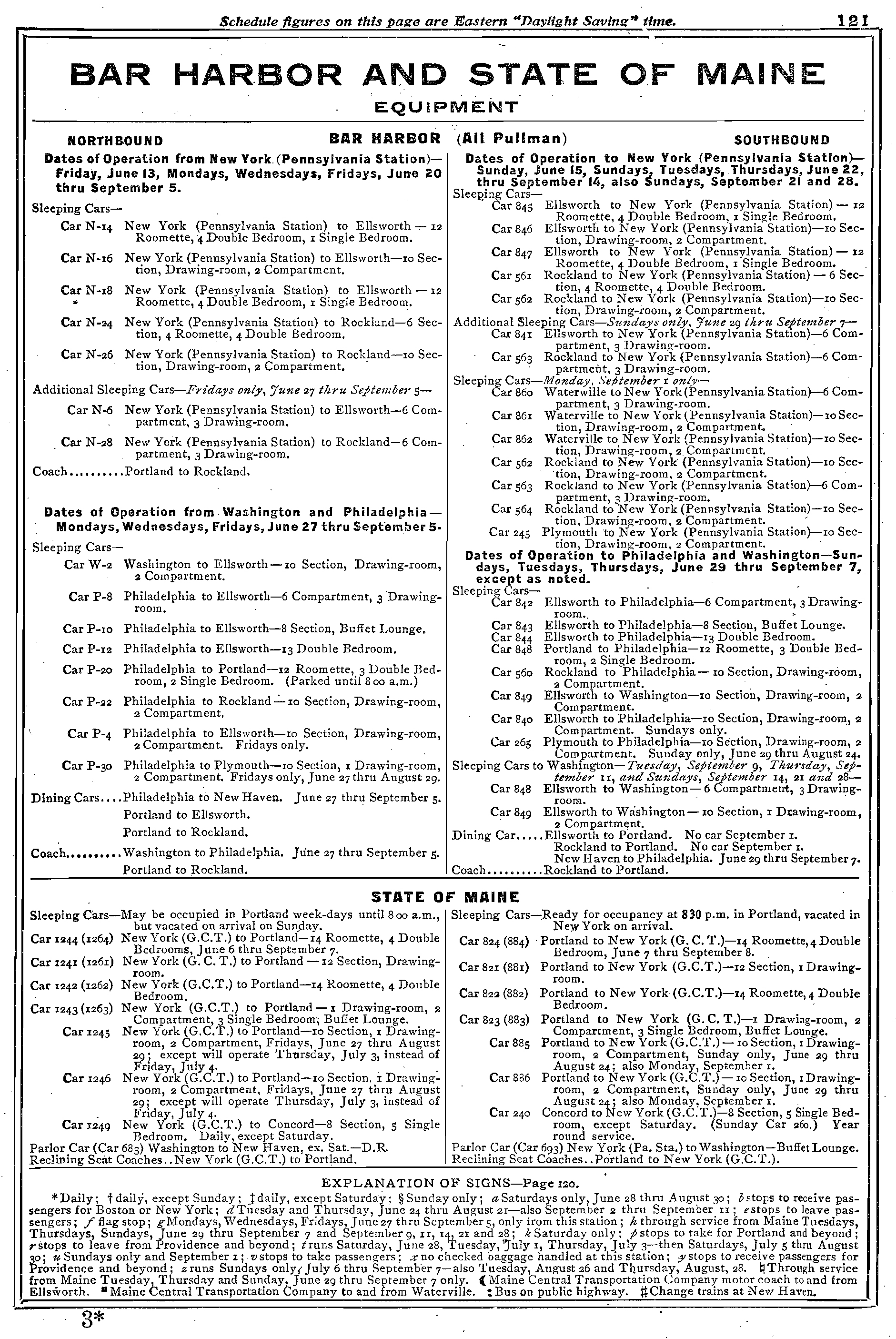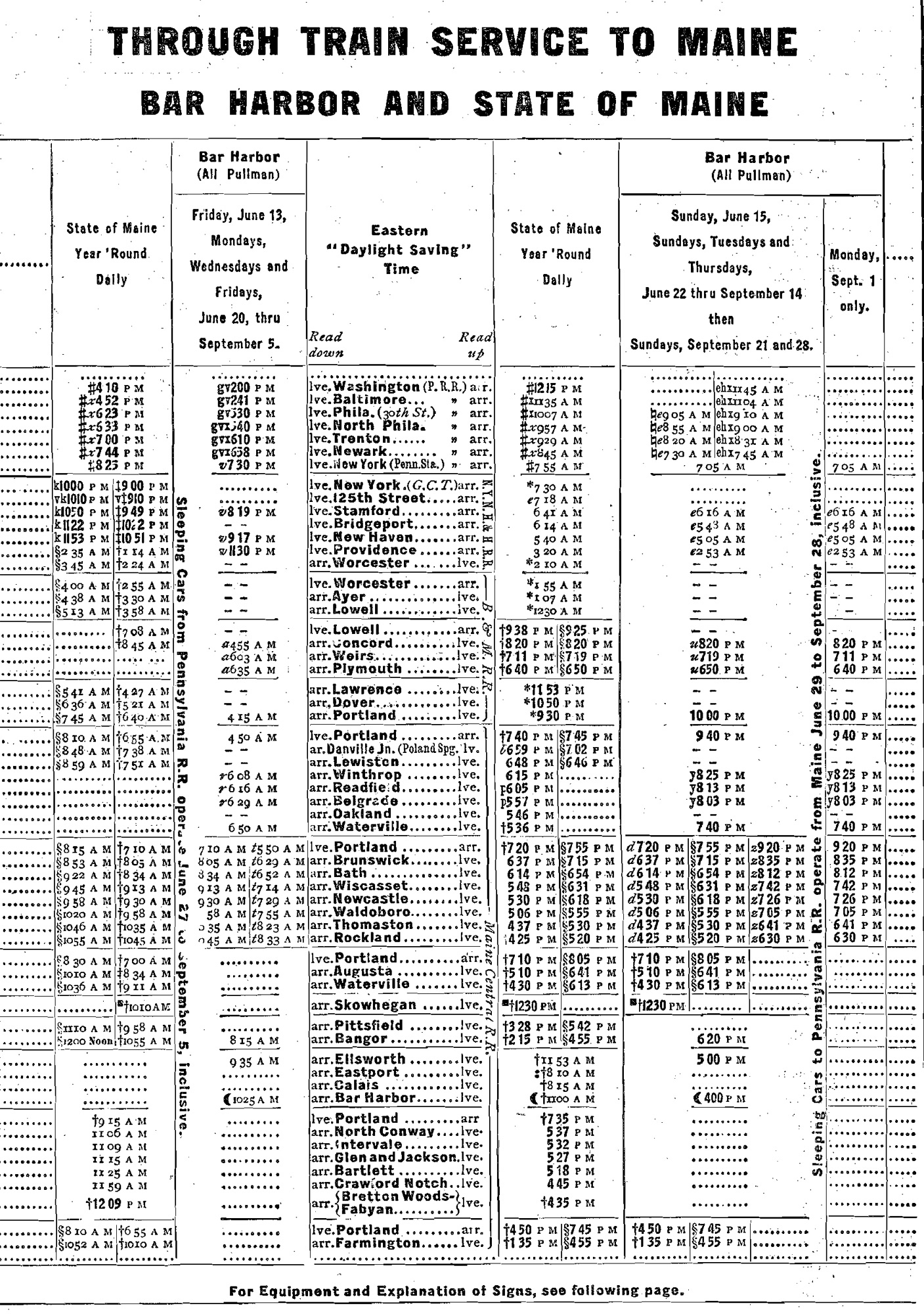The "Bar Harbor Express": To Maine's Bar Harbor Resorts
Last revised: September 11, 2024
By: Adam Burns
The Bar Harbor Express was a long-running seasonal train serving northern New England and southern areas of the Northeast, notably New York, Philadelphia, and Washington, D.C.
It was launched by the New Haven, Boston & Maine, and Maine Central during the early 20th century with through service to Philadelphia and Washington provided via the Pennsylvania. The train provided summer vacationers connections to resorts along Maine's Bar Harbor.
It was one of the region's few all-Pullman operations but enjoyed great success seeing high patronage for many years and considered one of the most important trains over all of the railroads it operated.
The train saw lightweight equipment added to its consist during the streamliner era and during its final years operated only a few days per week. It was discontinued in 1960, subject to the MEC's cessation of passenger operations.
History
The history of a seasonal train connecting the busy metropolitan areas of the Northeast with the tranquil solitude of Maine's coastal regions begins in 1887 when the B&M and Maine Central launched the seasonal Boston & Mount Desert Limited between Boston and Mount Desert Ferry according to Joseph P. Schwieterman's book, "When The Railroad Leaves Town: Eastern United States."
From the outset it was a seasonal run only operating during the summer months - roughly between mid-June and mid-September according to Kevin Holland's, "Passenger Trains Of Northern New England, In The Streamline Era."
Rail service to this region began in 1874 when the Bucksport & Bangor Railroad was completed between its namesake towns. In 1883 the Maine Shore Line Railroad extended rails further eastward from a connection with the B&B at Brewer Junction to Ellsworth and Hancock Point along Frenchman Bay.
Both lines were soon leased by the Maine Central, which initiated steamboat service from the point to Bar Harbor, a resort community located on Mount Desert Island. Following the Boston & Mount Desert Limited's launch, additional hotels sprang up, including the Bluffs Hotel at Hancock Point - completed by the Maine Central itself in 1895.
In 1898 the Washington County Railroad extended rails further east from Washington Junction - near Hancock - to Calais and Eastport, which was also later leased the MEC.
Officially, the Bar Harbor Express began in 1902 - a joint train operated by the New Haven, B&M, and MEC between New York and Hancock Point. It had various upgrades over the years; most notably in 1917 when, following the opening of Hell Gate Bridge, the train could run through into New York City.
The New Haven operated the train to Springfield, Massachusetts where it was handed off to the Boston & Albany (New York Central). The B&A carried it as far north as Worcester, Massachusetts with the Boston & Maine handling it into Portland Union Station.
However, the B&A would soon opt out of the arrangement and the train began running direct over the New Haven between New York-Worcester.
From Portland, the Maine Central operated the final leg to Bar Harbor and Hancock Point. Before the days of direct road access this wharf allowed passengers to de-board and catch a boat to reach the resorts at Bar Harbor.
- Direct service to the McNeil Point Wharf was discontinued after 1931 following the completion of highway service to the island. -
In 1917 the New Haven completed the Hell Gate Bridge into downtown Manhattan and a connection with the PRR's Pennsylvania Station. This new artery allowed the train's extension much further south, running essentially the entirety of the Northeast Corridor terminating at Washington, D.C.
Complete Consist (August, 1952)
With the extension the Bar Harbor Express gained additional patronage and Mr. Stilgoe's book states it regularly ran in three sections during the 1920s, occasionally even carrying privately-owned cars. From D.C. the train left every afternoon at 1 PM and arrived in Portland at 4:24 AM the following day.
From here it split into five different sections: one reached Kineo and Waterville; another connected with Rockland via Bath, Wiscasset, Waldoboro, and Thomaston; another reached North Conway, Crawfords, Bretton Woods, and Fabyan; there was a section to Kennebago; and finally, the popular section to Bar Harbor via Ellsworth and Mt. Desert Ferry.
The return southbound train left Bar Harbor at 2:00 PM each day and collected at Portland before connecting southward over the B&M.
Interestingly, because there was no direct connection between the North and South Stations, the contemporary Bar Harbor Express did not include a Boston section as Peter Maiken notes in his book, "Night Trains: The Pullman System in the Golden Years of American Rail Travel."
Initial Decline
It can be argued the train's decline began as early as 1931 when the causeway was completed Bar Harbor, ending the ferry connection and causing the train to be cutback to Ellsworth. To continue reaching Bar Harbor guests were forced to take motor coaches (buses), or in some cases chauffeured limousines.
More trouble occurred in 1933 when Ellsworth suffered a terrible fire to its downtown district, destroying many historic structures. Its population dropped by more than half and then MEC abandoned its branch between the town and Mount Desert Ferry in 1938.
Accommodations
According to a September, 38, 1941 timetable the train operated with several sleepers, a buffet-lounge (Ellsworth - Philadelphia), and a diner (New York - Washington, Bangor - Portland). During World War II the Bar Harbor Express saw service interrupted.
Nevertheless, it remained popular for some years following the conflict. In the streamliner era the train began fielding some lightweight Pullman equipment and modernized heavyweights but still generally operated with traditional heavyweight cars.
By the late 1940s it began witnessing its first widescale cutbacks operating north of Washington and Philadelphia only on Mondays, Wednesdays, and Fridays while departing Maine on Sundays, Tuesdays, and Thursdays according to Mr. Holland's book. Additionally, the train was terminated at Ellsworth where passengers could then take bus service to the island.
By 1955 services were further reduced; northbound runs occurred only on Tuesdays and Fridays and southbound trains operated on Wednesdays and Fridays. Interestingly, even in this late era the Bar Harbor still carried a total of seven sleepers at various points throughout the trip during weekday runs. Amazingly, three more sleepers were still added for the ever-busy weekend service at this time.
As the Maine Central reduced its passenger operations with great fervor throughout the 1950s the Bar Harbor was not immune from these cutbacks; in 1957 it lost through service to Ellsworth and operated no further than Bangor, forcing passengers to make the 30-mile ride via bus to the island.
Timetable (August, 1952)
Final Years
The MEC's efforts to end passenger service system-wide was finally granted after September 6, 1960, which included the Bar Harbor. Interestingly, for several years following the railroad continued to provide freight service over the Ellsworth line, which continued until 1985.
The many years of strong patronage the Bar Harbor enjoyed was one of the few success stories amongst New England passenger trains. It led to the Boston & Maine replicating service to other vacation destinations, which also proved a popular endeavor. Today, Mr. Stilgoe notes that several of these Maine resorts are still in operation albeit lacking rail service
Sources
- Holland, Kevin J. Passenger Trains Of Northern New England, In The Streamline Era. Lynchburg: TLC Publishing, 2004.
- Schafer, Mike. More Classic American Railroads. Osceola: MBI Publishing, 2000.
- Schwieterman, Joseph P. When The Railroad Leaves Town: Eastern United States. Kirksville: Truman State University Press, 2001.
Contents
Recent Articles
-
Rio Grande 2-8-2 Locomotives (K-37): Specs, Roster, Photos
Apr 15, 25 12:57 PM
Rio Grande's Class K-37 Mikes were itsdge steamers to enter service in the late 1920s. Today, all but two survive. -
Rio Grande 2-8-2 Locomotives (K-36): Specs, Roster, Photos
Apr 15, 25 11:09 AM
The Rio Grande's K-36 2-8-2s were its last new Mikados purchased for narrow-gauge use. Today, all but one survives. -
Rio Grande 2-8-2 Locomotives (Class K-28): Specs, Roster, Photos
Apr 14, 25 10:24 PM
Rio Grande's Class K-28 Mikados were its newest narrow-gauge steam locomotives since the Mudhens of the early 1900s. Today, three survive.




